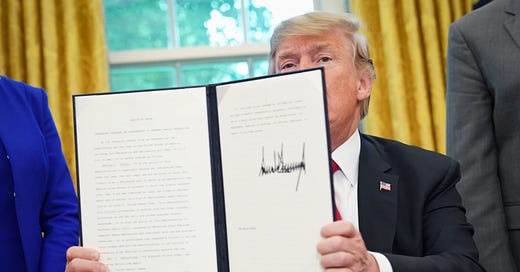
Courting Lawlessness
President Trump can’t blame the Supreme Court for whatever chaos he’s now cooking up.
For those of us who criticized President Obama’s “pen-and-phone” style of unrestrained administrative lawmaking, the Supreme Court’s latest decision reinforcing the basic restraints on the administrative state contained a bitter irony: The Court’s decision involved not one of the Obama administration’s actions, but one of the Trump administration’s. The challenge now is to grapple with how to apply that decision in a way that promotes the steady rule of law despite both presidents’ disregard for it.
In last month’s decision in Department of Homeland Security v. Regents of the University of California, the Supreme Court reiterated that administrative agencies cannot make or unmake substantive regulatory policies without first satisfying the basic requirements of administrative law, including the duty of giving a reasoned explanation for an administration’s action. In this case, the substantive regulatory policy in question was the Trump administration’s unwinding of the Obama administration’s DACA policy. (That is, “Deferred Action for Childhood Arrivals,” part of President Obama’s program of broad nonenforcement of America’s immigration laws.)
The Obama administration created its DACA policy in 2012; two years later, the administration expanded DACA and added the “DAPA” policy for immigrant parents. A coalition of states led by Texas then sought judicial review—and won. A federal trial judge issued an injunction blocking the DACA expansion and DAPA because of their evident violation of basic rules of administrative procedure; the U.S. Court of Appeals for the Fifth Circuit affirmed the judge’s injunction. The Obama administration appealed to the Supreme Court, but Justice Scalia died in 2016 while the case was pending; the remaining eight justices deadlocked 4-4, which left the Fifth Circuit’s decision standing without a majority opinion.
At the end of 2016, when President Trump won the presidency, there was little doubt that Obama’s immigration policy would be rolled back; the only questions were how and how quickly. The answers turned out to be “summarily,” and “quickly”: In early 2017 the Department of Homeland Security announced it was repealing DAPA; a few months later, at the behest of the Attorney General, DHS repealed DACA too.
There was a both a clear symmetry and a rough justice to it all—the Obama administration created DAPA and DACA with little more than the wave of a pen, and the Trump administration undid them the same way. Unfortunately, following the road map of a lawless administrative action leads one into rather risky territory. And that is what the Trump administration discovered last month, when the Supreme Court declared that the administrative process undoing DACA was unlawful because it failed to satisfy basic rules for administrative action.
The Court’s decision emphasized that both the Trump administration’s action at issue and the underlying Obama administration policy were not merely questions of enforcement discretion, which would have made them unreviewable by the courts and beyond the reach of the Administrative Procedure Act. Rather, the Court explained, “the DACA program is more than a non-enforcement policy,” and thus “its rescission is subject to review under the APA.” This echoed the older federal court decisions against the Obama administration, which saw DACA and DAPA to be substantive administrative policies that needed to go through the proper administrative process, with the requisite explanations and justifications from the agencies.
While last month’s case was directed at the Trump administration action, the rule that the Court announced applies much more broadly: When an administration announces a new substantive administrative policy that creates or changes previously created rights or obligations, the new policy has to satisfy the basic procedural and substantive requirements set by federal statutes. This basic rule of law binds the Trump administration, just as it would bind a Biden administration or any future administration. The Administrative Procedure Act is law just like any other federal statute is law, and the president is obligated to faithfully execute it.
But again, there is a palpable sense of unfairness in seeing the Supreme Court strike down Trump’s rollback of DACA, after the then-deadlocked eight-justice Court failed to produce a five-justice majority opinion declaring this rule against the Obama administration’s DACA and DAPA in the first place. And this sense of unfairness may be leading the Trump administration to draw wrong and, counterproductive lesson from the loss that the Court handed to it last month.
In President Trump’s new interview with Fox News Sunday’s Chris Wallace, the president mentioned the Court’s decision and explained that he sees it not as a restraint on unilateral administrative action, but an encouragement for it. Specifically, when Wallace mentioned the Trump administration’s failure to reform Obamacare, President Trump announced that major administrative actions—on Obamacare, immigration, and evidently other issues—would be coming very soon, and without precedent:
Excuse me. You heard me yesterday. We’re signing a health care plan within two weeks, a full and complete health care plan that the Supreme Court decision on DACA gave me the right to do. So we’re going to solve—we’re going to sign an immigration plan, a health care plan, and various other plans. And nobody will have done what I’m doing in the next four weeks. The Supreme Court gave the president of the United States powers that nobody thought the president had, by approving, by doing what they did—their decision on DACA. And DACA’s going to be taken care of also. But we’re getting rid of it because we’re going to replace it with something much better. What we got rid of already, which was most of Obamacare, the individual mandate. And that I’ve already won on. And we won also on the Supreme Court. But the decision by the Supreme Court on DACA allows me to do things on immigration, on health care, on other things that we’ve never done before. And you’re going to find it to be a very exciting two weeks. [Emphases added.]
This was a puzzling assertion: The Court’s DACA decision gave the president no powers; rather, the Court’s decision was the very opposite. But later on Sunday, Axios reported that the Trump administration believed that the real lesson of the DACA litigation was President Trump needs to take more unilateral actions more quickly, in the hopes that the courts will not strike them down.
According to Axios, the inspiration for this approach may have been a recent article by law professor John Yoo, an influential and thoughtful scholar of presidential power (and, as it happens, my friend and colleague at the American Enterprise Institute). In the article, Yoo criticizes the Court’s DACA decision as a misguided impairment of any president’s power to not enforce a policy that that president deems unlawful. Yoo, tracing the DACA dispute back to its pen-and-phone origins, warns that the Roberts Court has opened a door for presidents to “violate the law” in making new policies in the first place: A president could announce a new policy that violates federal laws and ignores the requisite processes, but his successor would have to go through that same requisite process before repealing the unlawful policy. Indeed, Yoo warns, even if that president “knew that his scheme lacked legal authority, he could get away with it for the length of his presidency” (emphasis added).
Yoo has written eloquently on the fact that DACA and DAPA themselves raised grave questions of President Obama’s failure to “take care that the laws be faithfully executed,” and so his new essay rightly frames this approach to presidential lawmaking as plainly unlawful. But President Trump seems to take Yoo’s article less as a warning against lawless presidential actions, and more as a road map for the remainder of his first (and perhaps only) presidential term.
Yet the Court’s own decision can be read to avoid the problems that Yoo warns against. For while it is true that the Court’s new decision involved an administration’s attempt to repeal a substantive policy, the rule that the Court announced applies equally to administrative actions that both repeal and create substantive policies. That evenhanded applicability makes sense: Federal law applies the same procedural rules to administrative actions creating new policies and administrative actions reforming or repealing old ones, and the Court’s new decision framed its ruling in the same symmetrical terms. It was not limited just to an administration’s attempts to roll back old policies.
So what would happen if President Trump were to take the Court’s DACA decision as a green light for knowingly lawless actions in the weeks ahead? Most likely, federal courts will block those new policies from taking effect in the first place, and when they do so they will cite cases like DHS v. Regents. That would be the right outcome, for reasons of what Alexander Hamilton once called “the steady administration of the laws.”










